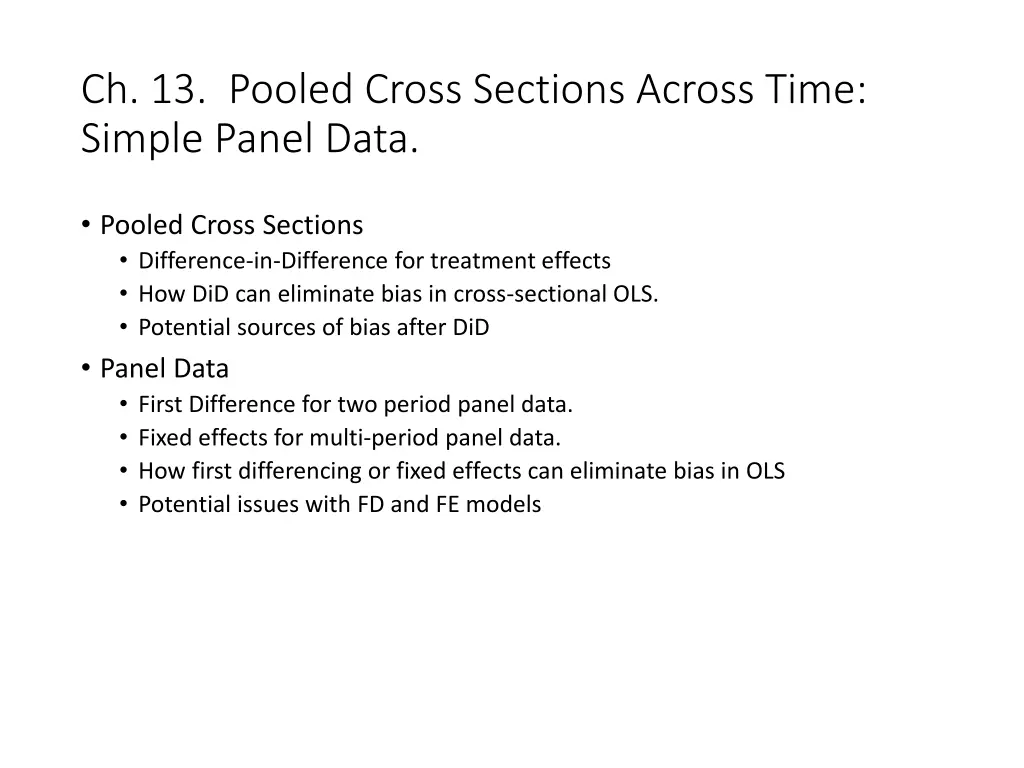
Analyzing Policy Impacts with Difference-in-Differences Methods
Explore how Difference-in-Differences (DiD) methodologies can help eliminate bias in cross-sectional OLS, assess treatment effects in panel data, and evaluate policy changes using pooled cross-sections across time. Understand the significance of DiD in addressing biases and identifying causal effects in various scenarios.
Download Presentation

Please find below an Image/Link to download the presentation.
The content on the website is provided AS IS for your information and personal use only. It may not be sold, licensed, or shared on other websites without obtaining consent from the author. If you encounter any issues during the download, it is possible that the publisher has removed the file from their server.
You are allowed to download the files provided on this website for personal or commercial use, subject to the condition that they are used lawfully. All files are the property of their respective owners.
The content on the website is provided AS IS for your information and personal use only. It may not be sold, licensed, or shared on other websites without obtaining consent from the author.
E N D
Presentation Transcript
Ch. 13. Pooled Cross Sections Across Time: Simple Panel Data. Pooled Cross Sections Difference-in-Difference for treatment effects How DiD can eliminate bias in cross-sectional OLS. Potential sources of bias after DiD Panel Data First Difference for two period panel data. Fixed effects for multi-period panel data. How first differencing or fixed effects can eliminate bias in OLS Potential issues with FD and FE models
Pooling Cross Sections across Time: Simple Panel Data Methods Policy analysis with pooled cross sections Two or more independently sampled cross sections can be used to evaluate the impact of a certain event or policy change Effect of new garbage incinerator s location on housing prices Examine the effect of the location of a house on its price before and after the garbage incinerator was built: After incinerator was built Before incinerator was built
Pooling Cross Sections across Time: Simple Panel Data Methods Garbage incinerator and housing prices Note: near incinerator had negative effect on housing prices before incinerator was built? Why? Would be inappropriate to interpret negative effect of incinerator after it s built as a causal effect. Some of effect is due to fact that incinerator was built near lower price homes. More appropriate to look at difference-in-difference (DiD) after incinerator was built: p near p far = -30,688.27 before incinerator was built: = p near p far = -18,824.37 difference in differences (DiD) = -11,863.9
Pooling Cross Sections across Time: Simple Panel Data Methods Difference-in-differences in a regression framework Difference in change of house price for those near vs not near incinerator (diff-in-diff) Show how ?1 is the DiD estimator derived above DiD regression allows for standard errors and t-stat of DiD effect. If houses sold before and after the incinerator was built were systematically different, further explanatory variables should be included Adding housing characteristics will also reduce the error variance and thus standard errors Before/After comparisons in natural experiments DiD can be used to evaluate policy changes or other exogenous events
Pooling Cross Sections across Time: Simple Panel Data Methods Policy evaluation using difference-in-differences Compare outcomes of the two groups before and after the policy change Suppose that something happens in the treated group causing its growth to differ by ? relative to the control group. DiD estimator will then include true effect of treatment (?1) and the effect of the other factors causing growth to differ by ? in the treated group. Examples. Minimum wage increase is the treatment. How is DiD estimate of employment effect biased if the state that passes the minimum wage has unusually high economic growth? Unusually low economic growth? Might use placebotest to be sure that DiD estimator isn t picking up effect of some other factor. Minimum wage hike shouldn t affect employment growth of college graduates.
Pooling Cross Sections across Time: Simple Panel Data Methods Two-period panel data (Fixed Effect) analysis Example: Effect of unemployment on city crime rate Assume that no other explanatory variables are available. Will it be possible to estimate the causal effect of unemployment on crime? Yes, if cities are observed for at least two periods and other factors affecting crime stay approximately constant over those periods: Unobserved city specific time-invariant actors (= fixed effect) Time dummy for the second period Other unobserved factors (= idiosyncratic error) Examples of time-constant variables that might affect city crime?
Pooling Cross Sections across Time: Simple Panel Data Methods Effect of unemployment on city crime rate Estimate differenced equation by OLS: Fixed effect drops out + 1 percentage point unemploy- ment rate leads to 2.22 more crimes per 1,000 people Secular increase in crime across all cities.
Pooling Cross Sections across Time: Simple Panel Data Methods Discussion of first-differenced panel estimator Further explanatory variables may be included in original equation There may be arbitrary correlation between the unobserved time-invariant characteristics and the included explanatory variables For example, suppose cities with less educated workers (virtually a time-invariant characteristic) have higher crime and also higher unemployment how would this bias OLS estimate of effect of unemployment? First differences cause effect of any time-invariant variables to be differenced out of the regression. Eliminates bias from exclusion of important time- invariant variables that would emerge in OLS. First-differenced estimates will be imprecise if explanatory variables vary little over time (no estimate possible if time-invariant)
Panel Data Methods with More than 2 Periods. Fixed effects estimation Fixed effect, potentially correlated with explanatory variables Form time-averages for each individual Because (the fixed effect is removed) Estimate deviations from i-specific means using OLS Estimates rely on time variation within cross-sectional units (= within estimator) xtset & xtreg in Stata.
Advanced Panel Data Methods Example: Effect of training grants on firm scrap rate (number of defective items per 100 produced) Time-invariant reasons why one firm is more productive than another are controlled for. The important point is that these may be correlated with the other explanatory variables. Stars denote deviations from i-specific means Fixed-effects estimation using the years 1987, 1988, and 1989: Training grants significantly improve productivity (with a time lag)
Advanced Panel Data Methods Discussion of fixed effects estimator Strict exogeneity in the original model has to be assumed The R2 of the demeaned equation is inappropriate measure of R2 The effect of time-invariant variables cannot be estimated The effect of interactions with time-invariant variables can be estimated (e.g. the interaction of education with time dummies) If a full set of time dummies are included, the effect of variables whose change over time is constant cannot be estimated (e.g. age) Degrees of freedom have to be adjusted because the individual specific averages are estimated in addition to other coefficients (resulting degrees of freedom = NT-N-k)
Advanced Panel Data Methods (Ch.14) Applying panel data methods to other data structures Panel data methods can be used in other contexts where constant unobserved effects have to be removed Example: Wage equations for twins Unobserved genetic and family characteristics that do not vary across twins Equation for twin 1 in family i Equation for twin 2 in family i Estimate differenced equation by OLS






















